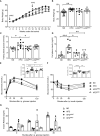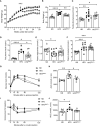N-acetyl-L-cysteine treatment reduces beta-cell oxidative stress and pancreatic stellate cell activity in a high fat diet-induced diabetic mouse model
- PMID: 36093092
- PMCID: PMC9452715
- DOI: 10.3389/fendo.2022.938680
N-acetyl-L-cysteine treatment reduces beta-cell oxidative stress and pancreatic stellate cell activity in a high fat diet-induced diabetic mouse model
Abstract
Obesity plays a major role in type II diabetes (T2DM) progression because it applies metabolic and oxidative stress resulting in dysfunctional beta-cells and activation of intra-islet pancreatic stellate cells (PaSCs) which cause islet fibrosis. Administration of antioxidant N-acetyl-L-cysteine (NAC) in vivo improves metabolic outcomes in diet-induced obese diabetic mice, and in vitro inhibits PaSCs activation. However, the effects of NAC on diabetic islets in vivo are unknown. This study examined if dosage and length of NAC treatment in HFD-induced diabetic mice effect metabolic outcomes associated with maintaining healthy beta-cells and quiescent PaSCs, in vivo. Male C57BL/6N mice were fed normal chow (ND) or high-fat (HFD) diet up to 30 weeks. NAC was administered in drinking water to HFD mice in preventative treatment (HFDpNAC) for 23 weeks or intervention treatment for 10 (HFDiNAC) or 18 (HFDiNAC+) weeks, respectively. HFDpNAC and HFDiNAC+, but not HFDiNAC, mice showed significantly improved glucose tolerance and insulin sensitivity. Hyperinsulinemia led by beta-cell overcompensation in HFD mice was significantly rescued in NAC treated mice. A reduction of beta-cell nuclear Pdx-1 localization in HFD mice was significantly improved in NAC treated islets along with significantly reduced beta-cell oxidative stress. HFD-induced intra-islet PaSCs activation, labeled by αSMA, was significantly diminished in NAC treated mice along with lesser intra-islet collagen deposition. This study determined that efficiency of NAC treatment is beneficial at maintaining healthy beta-cells and quiescent intra-islet PaSCs in HFD-induced obese T2DM mouse model. These findings highlight an adjuvant therapeutic potential in NAC for controlling T2DM progression in humans.
Keywords: HFD-induced diabetes; N-acetyl-L-cysteine (NAC); beta-cell oxidative stress; collagen fiber; pancreatic stellate cells (PaSCs).
Copyright © 2022 Schuurman, Wallace, Sahi, Barillaro, Zhang, Rahman, Sawyez, Borradaile and Wang.
Conflict of interest statement
The authors declare that the research was conducted in the absence of any commercial or financial relationships that could be construed as a potential conflict of interest.
Figures








Similar articles
-
Long-Term Administration of Antioxidant N-Acetyl-L-Cysteine Impacts Beta Cell Oxidative Stress, Insulin Secretion, and Intracellular Signaling Pathways in Aging Mice.Antioxidants (Basel). 2025 Mar 31;14(4):417. doi: 10.3390/antiox14040417. Antioxidants (Basel). 2025. PMID: 40298742 Free PMC article.
-
Maternal N-Acetyl Cysteine Intake Improved Glucose Tolerance in Obese Mice Offspring.Int J Mol Sci. 2020 Mar 13;21(6):1981. doi: 10.3390/ijms21061981. Int J Mol Sci. 2020. PMID: 32183232 Free PMC article.
-
Early intervention of N-acetylcysteine better improves insulin resistance in diet-induced obesity mice.Free Radic Res. 2018 Dec;52(11-12):1296-1310. doi: 10.1080/10715762.2018.1447670. Free Radic Res. 2018. PMID: 29502477
-
Pancreatic stellate cells in the islets as a novel target to preserve the pancreatic β-cell mass and function.J Diabetes Investig. 2020 Mar;11(2):268-280. doi: 10.1111/jdi.13202. Epub 2020 Jan 24. J Diabetes Investig. 2020. PMID: 31872946 Free PMC article. Review.
-
Impacts of high fat diet on ocular outcomes in rodent models of visual disease.Exp Eye Res. 2021 Mar;204:108440. doi: 10.1016/j.exer.2021.108440. Epub 2021 Jan 11. Exp Eye Res. 2021. PMID: 33444582 Free PMC article. Review.
Cited by
-
Vitamin D Alleviates Type 2 Diabetes Mellitus by Mitigating Oxidative Stress-Induced Pancreatic β-Cell Impairment.Exp Clin Endocrinol Diabetes. 2023 Dec;131(12):656-666. doi: 10.1055/a-2191-9969. Epub 2023 Nov 7. Exp Clin Endocrinol Diabetes. 2023. PMID: 37935388 Free PMC article.
-
NRF2 deficiency leads to inadequate beta cell adaptation during pregnancy and gestational diabetes.Redox Biol. 2025 Apr;81:103566. doi: 10.1016/j.redox.2025.103566. Epub 2025 Feb 24. Redox Biol. 2025. PMID: 40054060 Free PMC article.
-
NRF2 is required for neonatal mouse beta cell growth by maintaining redox balance and promoting mitochondrial biogenesis and function.Diabetologia. 2024 Mar;67(3):547-560. doi: 10.1007/s00125-023-06071-7. Epub 2024 Jan 11. Diabetologia. 2024. PMID: 38206362 Free PMC article.
-
Supplementary Effects of Allium hookeri Extract on Glucose Tolerance in Prediabetic Subjects and C57BL/KsJ-db/db Mice.Pharmaceuticals (Basel). 2023 Sep 27;16(10):1364. doi: 10.3390/ph16101364. Pharmaceuticals (Basel). 2023. PMID: 37895834 Free PMC article.
-
Synergistic Effect of a Flavonoid-Rich Cocoa-Carob Blend and Metformin in Preserving Pancreatic Beta Cells in Zucker Diabetic Fatty Rats.Nutrients. 2024 Jan 17;16(2):273. doi: 10.3390/nu16020273. Nutrients. 2024. PMID: 38257166 Free PMC article.
References
-
- McAdam-Marx C, Mukherjee J, Bellows BK, Unni S, Ye X, Iloeje U, et al. . Evaluation of the relationship between weight change and glycemic control after initiation of antidiabetic therapy in patients with type 2 diabetes using electronic medical record data. Diabetes Res Clin Pract (2014) 103:402–11. doi: 10.1016/j.diabres.2013.12.038 - DOI - PubMed
-
- Temelkova-Kurktschiev T, Siegert G, Bergmann S, Henkel E, Koehler C, Jaroß W, et al. . Subclinical inflammation is strongly related to insulin resistance but not to impaired insulin secretion in a high risk population for diabetes. Metabolism (2002) 51:743–9. doi: 10.1053/meta.2002.32804 - DOI - PubMed
Publication types
MeSH terms
Substances
LinkOut - more resources
Full Text Sources
Medical

